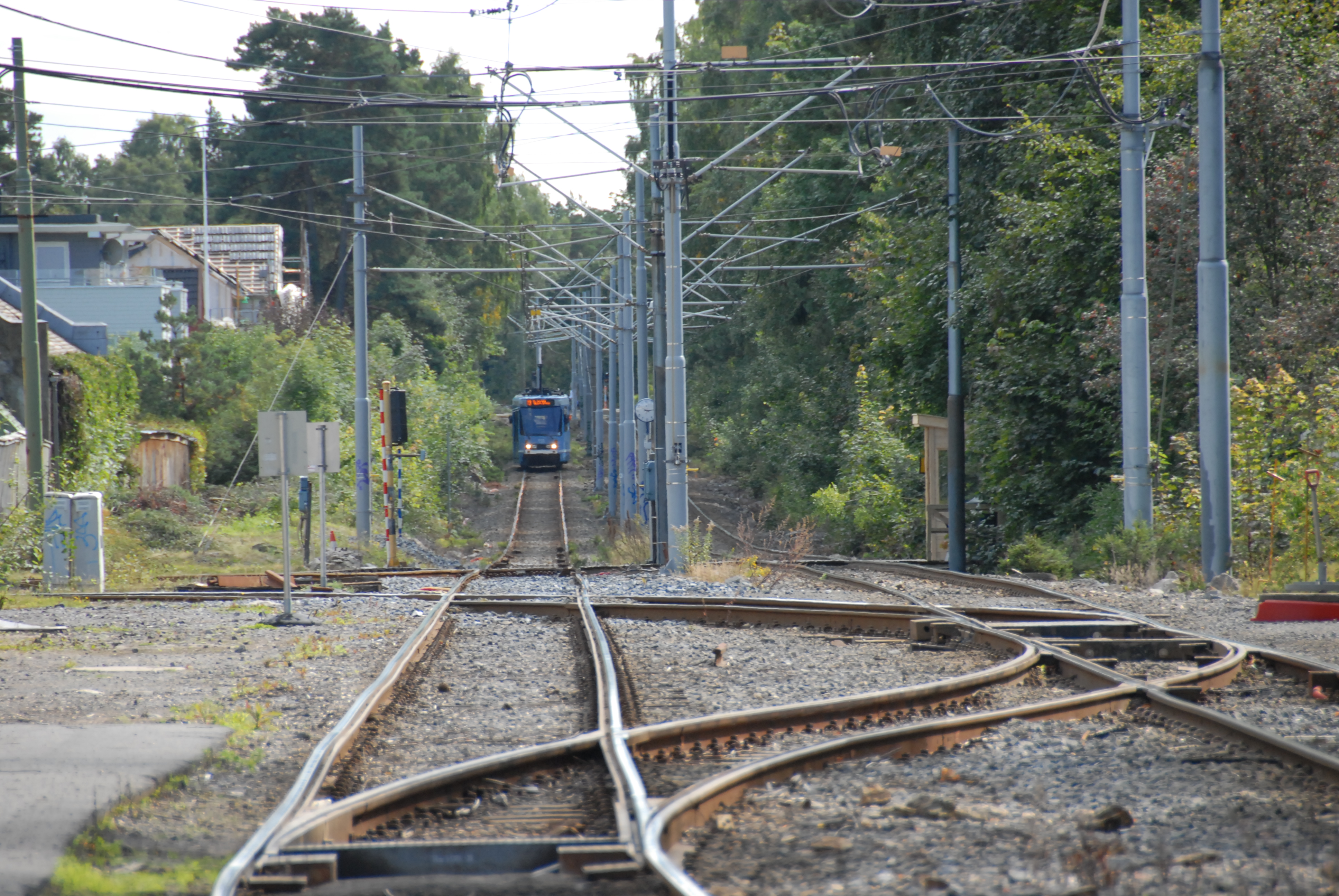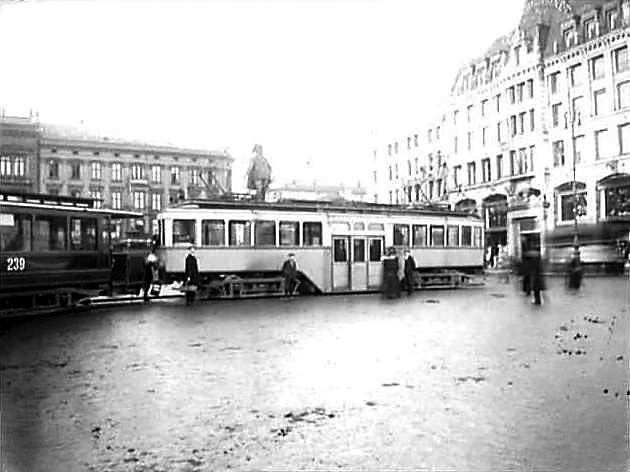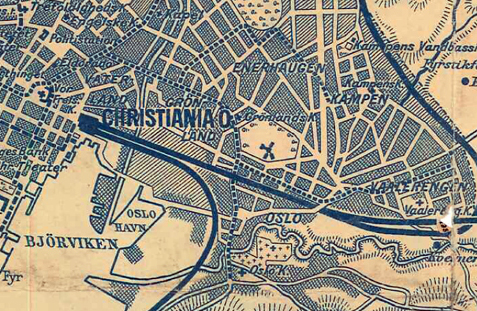|
Ekebergbanen
The Ekeberg Line ( no, Ekebergbanen) is a long light rail line of the Oslo Tramway which runs from Oslo Hospital to Ljabru in Oslo, Norway. Operated by lines 13 and 19, it serves the area of Nordstrand and the neighborhoods of Ekeberg, Jomfrubråten, Bekkelaget and Ljan. The line is operated by Oslo Sporvognsdrift using SL79 and SL95 trams on contract with Ruter. The line itself is owned by Sporveien. At Oslo Hospital, the line connects to the Bjørvika Line, which runs to the city center. Proposals for a line in the area were first launched 1897, but not until 1914 were the necessary permits granted. The line was built and operated by Ekebergbanen. The line opened in 1917, and connected to the Gamleby Line to reach Stortorvet in the city center. The line differed from the street trams in that it ran in its own right of way and used 1,200 volt supply, unlike the 600 volts used in the streets. In the early 1930s, the line was rebuilt to double track and a branch, the ... [...More Info...] [...Related Items...] OR: [Wikipedia] [Google] [Baidu] |
Ekebergbanen (company)
AS Ekebergbanen was a private company that built and operated the Ekeberg Line in Oslo, Norway. It was founded 27 March 1914, and the line opened 11 June 1917 from Stortorvet to Sæter. The company also built a line to Simensbråten that was closed 29 October 1967. Ekebergbanen also operated buses in Oslo. History The company was founded on 24 March 1914, and started construction of the line immediately, but the delivery of technical equipment and rolling stock was delayed because of the First World War. The company's formal establishment was therefore made on 1 June 1917, when the line between Stortorvet and Sæter was opened. In 1918, AS Ekebergbanen sent an application to build a funicular from Gamlebyen (then called Oslo) to Ekebergplatået. The stations were mostly built with tiny wooden sheds in new baroque architectural style by the Norwegian architect Erik Glosimodt. On the station Holtet, a larger station building was constructed, also drawn by Erik Glosimodt. This ... [...More Info...] [...Related Items...] OR: [Wikipedia] [Google] [Baidu] |
Simensbråten Line
The Simensbråten Line ( no, Simensbråtenlinjen) was a light rail line of Oslo Tramway between Jomfrubråten and Simensbråten in Oslo, Norway. Opening on 30 September 1931, it branched off the Ekeberg Line at Jomfrubråten and had three stops along the route— Ekebergparken, Smedstua and Simensbråten. Operated by Ekebergbanen, the line was closed on 29 October 1967. It is the only light rail line in Oslo to have been closed. __TOC__ Route The Simensbråten Line was a long branch of the Ekeberg Line. It branched off south of Jomfrubråten and had three stations: Ekebergparken, Smedstua and Simensbråten. The line started at above mean sea level and terminated at above mean sea level. The line served the areas of Ekeberg and Simensbråten. In rush hour Ekebergbanen provided direct services to the city center, but otherwise only provided a shuttle service to Jomfrubråten. History In 1918, AS Ekebergbanen sent an application to build a funicular from Gamlebyen (then ... [...More Info...] [...Related Items...] OR: [Wikipedia] [Google] [Baidu] |
Oslo Sporveier
AS Oslo Sporveier is a defunct municipal owned company responsible for public transport in Oslo, Norway. It was created in 1924 to take over the city's two private tram companies. In 1927 its started with bus transport, including from 1940 to 1968 trolleybuses. Since 1966 rapid transit and from 1985 water buses have also been operated by the company. It was split into two separate companies in 2006; Kollektivtransportproduksjon took over the operation while Oslo Public Transport Administration (who retained the Oslo Sporveier brand) was responsible for buying the services, fare regulation and marketing. The latter merged into Ruter in 2008, when the Oslo Sporveier brand was discontinued. History It all started with trams In 1875, Kristiania Sporveisselskab (KSS) started the first horsecar services in Oslo—at the time called Kristiania. It was followed by Kristiania Elektriske Sporvei (KES) who established electric tram services in 1894; by 1900 KSS had also converted its route ... [...More Info...] [...Related Items...] OR: [Wikipedia] [Google] [Baidu] |
Gamlebyen Line
The Gamlebyen Line ( no, Gamlebylinjen) was a section of the Oslo Tramway which ran east from Jernbanetorget along Schweigaards gate (street), past the Bjørvika then turns south along Oslo gate, and past Gamlebyen before becoming the Ekeberg Line. The section was served by lines 18 and 19 before it was replaced by Bjørvika Line since October 2020. History The line was opened by Kristiania Sporveisselskab in 1875 as a horsecar route between Stortorvet and Gamlebyen. In 1900 the line was electrified, and received branch lines to Kampen and Vålerenga. The Vålerenga Line was extended to Etterstad in 1923, where there was a transfer to the Østensjø Line. Until 1925, the line was named the Oslo Line; with the name change of the city from Kristiania to Oslo, the district known as Oslo was renamed Gamlebyen. The plans from 1919 called for a common connection from the Østensjø Line and the Ekeberg Line to the city center, along with the proposed Lambertseter Line. The Ekberg Line ... [...More Info...] [...Related Items...] OR: [Wikipedia] [Google] [Baidu] |
Oslo Tramway
The Oslo tram network ( no, Trikken i Oslo, short from ', 'electric') is the tram system in Oslo, Norway. It consists of six lines with 99 stops and has a daily ridership of 132,000. It is operated by , a subsidiary of the municipally-owned who maintain the track and 72 tram vehicles on contracts with the public transport authority . The system operates on standard gauge and uses 750 V DC overhead. Depot, workshops and headquarters are at (at the terminus of lines 13 and 17). There is also a depot at (along lines 18 and 19) that is home to the technical company InfraPartner, which maintains the track for the tram and metro systems in Oslo, and a small office building for . History The first tram in Oslo was opened in 1875 with a short line between Homansbyen west of the city centre, Oslo West Railway Station and a sideline to Grønland, east of the city centre. The first "trams" were in fact horse-drawn vehicles on flanged steel wheels. The first expansion of the line came ... [...More Info...] [...Related Items...] OR: [Wikipedia] [Google] [Baidu] |
Oslo Hospital Tram Stop
Oslo Hospital is a light rail tram stop on the Ekeberg Line of the Oslo Tramway. It is located near Oslo Hospital in Ekeberg, in the borough of Gamlebyen The Old Town of Oslo ( no, Gamlebyen, ) is a neighbourhood in the inner city of Oslo, Norway, belonging to the borough of Gamle Oslo and is the oldest urban area within the current capital. This part of the capital of Norway was simply called ..., in Oslo, Norway. The station opened on 2 December 1878 as the terminus of the second segment of the Gamleby Line built by Kristiania Sporveisselskab. It was renamed following the change of name of the city from Kristiania to Oslo in 1925. On 11 June 1917 it also became the first station on the Ekeberg Line, after Ekebergbanen had built the suburban tramway to Sæter. The station is served by lines 13 and 19, using both SL79 and SL95 trams. Now, it is currently the terminus of the Bjørvika Line. References Oslo Tramway stations in Oslo Railway stations opene ... [...More Info...] [...Related Items...] OR: [Wikipedia] [Google] [Baidu] |
Oslo Hospital (station)
Oslo Hospital is a light rail tram stop on the Ekeberg Line of the Oslo Tramway. It is located near Oslo Hospital in Ekeberg, in the borough of Gamlebyen, in Oslo, Norway. The station opened on 2 December 1878 as the terminus of the second segment of the Gamleby Line built by Kristiania Sporveisselskab. It was renamed following the change of name of the city from Kristiania to Oslo in 1925. On 11 June 1917 it also became the first station on the Ekeberg Line, after Ekebergbanen had built the suburban tramway to Sæter. The station is served by lines 13 and 19, using both SL79 and SL95 trams. Now, it is currently the terminus of the Bjørvika Line The Bjørvika Line is a tram line in Sentrum and Gamleby in Oslo. It opened as a rerouting of the Gamleby Line. The former route was closed down on the same day of this line's opening. It has two stops, Bjørvika and Middelalderparken. It runs .... References Oslo Tramway stations in Oslo Railway stations opened in 1875 1 ... [...More Info...] [...Related Items...] OR: [Wikipedia] [Google] [Baidu] |
Jomfrubråten
Jomfrubråten is a residential area of Nordstrand in Oslo, Norway.Thorsnæs. It is located approximately away from the city centre. The area was disintegrated from Ekeberg in 1920, and made a residential area when the Ekeberg Line opened in 1917. A station with the same name serves the area on the Ekeberg Line, and formerly on the Simensbråten Line The Simensbråten Line ( no, Simensbråtenlinjen) was a light rail line of Oslo Tramway between Jomfrubråten and Simensbråten in Oslo, Norway. Opening on 30 September 1931, it branched off the Ekeberg Line at Jomfrubråten and had three stop ..., but the latter line was closed in 1967.Andersen, 43.Ruter. Citations Notes References * * * Neighbourhoods of Oslo {{oslo-geo-stub ... [...More Info...] [...Related Items...] OR: [Wikipedia] [Google] [Baidu] |
Nordstrand, Norway
Nordstrand () is a borough of the city of Oslo, Norway. It borders Gamle Oslo in the north, Østensjø in the east and Søndre Nordstrand in the south. The borough is located in the southern part of the city and with a population of 52,459 people as of 2020. In 2004, Nordstrand was merged with two other boroughs, Lambertseter and Ekeberg-Bekkelaget, to form what is today known simply as Nordstrand. First and second generation immigrants make up 14.6% of the population, which is the lowest percentage in the entire city. The borough is named after a house named ''Nordstranden'', located at Mosseveien 196. Nordstrand is one of the wealthiest boroughs in Oslo, and net incomes, real estate prices, and life expectancy are among the city's highest. In demographic statistics Oslo is usually divided into an eastern and a western part. As Nordstrand differs significantly from its bordering boroughs, it is often considered as belonging to the western part even though it is geographically lo ... [...More Info...] [...Related Items...] OR: [Wikipedia] [Google] [Baidu] |
Stortorvet (station)
Stortorvet is a tram stop on the Oslo Tramway in Oslo, Norway. The station is located on the square Stortorvet in the city centre A city centre is the commercial, cultural and often the historical, political, and geographic heart of a city. The term "city centre" is primarily used in British English, and closely equivalent terms exist in other languages, such as "" in Fren .... It is served by the lines 17, 18 and 19. In 2009, it was decided to improve the square, the station and the tram tracks in the street. References Oslo Tramway stations in Oslo {{oslo-tram-stub ... [...More Info...] [...Related Items...] OR: [Wikipedia] [Google] [Baidu] |
Bjørvika Line
The Bjørvika Line is a tram line in Sentrum and Gamleby in Oslo. It opened as a rerouting of the Gamleby Line. The former route was closed down on the same day of this line's opening. It has two stops, Bjørvika and Middelalderparken. It runs along Dronning Eufemias gate and Bispegata, instead of through Schweigaards gate and Munkegata. It is served by lines 13 and 19. Line 13 operates between Bekkestua and Ljabru, while Line 19 operates between Majorstuen and Ljabru. The section in Dronning Eufemias gate was constructed in the early 2010s, but the section between Bjørvika and Oslo Hospital, was only completed in 2021. The reason for this is the construction of the Follo Line project. Route It starts from Dronningens gate tram stop, through Prinsens gate and past the Bjørvika Public Library. It goes along Dronning Eufemias gate until it stops at Bjørvika. Afterwards, it follows down Dronning Eufemias gate through Bispegata before heading to Middelalderparken. From Middelal ... [...More Info...] [...Related Items...] OR: [Wikipedia] [Google] [Baidu] |
Ruter
Ruter AS is the public transport authority for Oslo and Akershus counties in Norway. Formally a limited company – 60% of its shares are owned by the Oslo county municipality and 40% by that of Akershus – it is responsible for the administration, funding, and marketing (but not direct operation) of public transport in the two counties, including buses, the Oslo Metro (''T-banen i Oslo''), Oslo Trams (''Trikken i Oslo''), and ferry services. Ruter also holds agreements with Norwegian State Railways concerning the regulation of fares on local and regional train services operated within the two counties. Operation The operation of services is performed by other companies: *Bus routes are subject to public service obligation, and operators include UniBuss, Nettbuss, Norgesbuss, Schau's Buss, and Nobina Norge. *The metro system is operated by Sporveien T-banen while the tramway is operated by Sporveien Trikken, both subsidiaries of the municipally owned Sporveien Oslo A ... [...More Info...] [...Related Items...] OR: [Wikipedia] [Google] [Baidu] |




